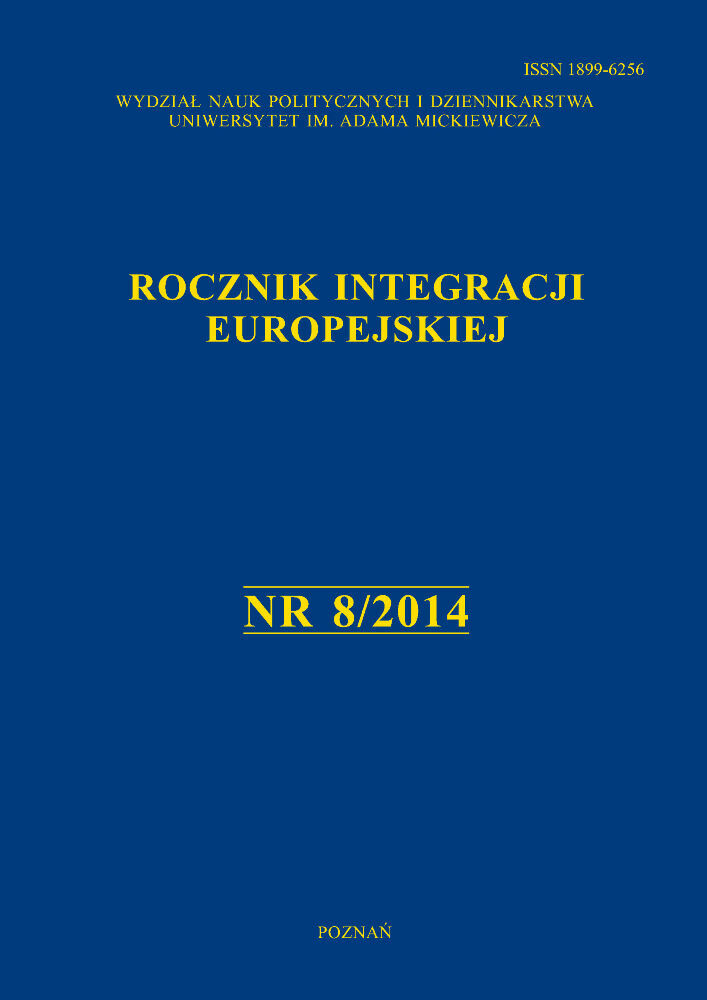Abstrakt
Celem niniejszego artykułu jest przedstawienie nowego koniunktywnego podejścia w badaniach integracji europejskiej: deliberatywnej fuzji międzyrządowej. Bazuje ono na połączeniu liberalnej teorii międzyrządowej, teorii fuzji i teorii deliberatywnego supranacjonalizmu. Główną myślą jest stwierdzenie, że żadna z istniejących koncepcji teoretycznych nie jest w stanie wyjaśnić istoty procesów integracyjnych w ramach Unii Europejskiej. W artykule przedstawiono podstawowe założenia wskazanych teorii (traktowanych jako koncepcje wyjściowe), przeanalizowano główne cechy Unii Europejskiej w czasie kryzysu, a także zaprezentowano podstawowe elementy nowego podejścia. Zaproponowana koncepcja powinna wykazywać przydatność nie tylko w sytuacji kryzysowej, ale także oferować instrumenty analizy integracji europejskiej w okresie pokryzysowym.
Bibliografia
Cichocki M. (2012), Zmiana niemieckiego paradygmatu w Europie, „Analizy Natolińskie”, nr 2.
Curtin D., Egeberg M. (2008), Tradition and Innovation: Europe’s Accumulated Executive Order, „West European Politics”, vol. 31, nr 4, s. 639–661.
Czachór Z. (2013), Kryzys i zaburzona dynamika Unii Europejskiej,Wydawnictwo Elipsa,Warszawa.
Diez T., Wiener A. (2009), Introducing the Mosaic of Integration Theory, w: European Integration Theory, red. A. Wiener, T. Diez, Oxford University Press, Oxford, s. 1–22.
Finke D. (2009), Challenges to Intergovernmentalism: an Empirical Analysis of EU Treaty Negotiations Since Maastricht, „West European Politics”, vol. 32, nr 3, s. 466–495.
Holzinger K., Schimmelfennig F. (2012), Differentiated Integration in the European Union: Many Concepts, Sparse Theory, Few Data, „Journal of European Public Policy”, vol. 19, nr 2, s. 292–305.
Joerges C. (2002), ‘Deliberative Supranationalism’– Two Defences, „European Law Journal”, vol. 8, nr 1, s. 133–151.
Kölliker A. (2001), Bringing Together or Driving Apart the Union? Towards a Theory of Differentiated Integration, „West European Politics”, vol. 24, nr 4, s. 125–151.
Kunstein T.,Wessels W. (2011), Die Europäische Union in der Währungskrise: Eckdaten und Schlüsselentscheidungen, „Integration”, nr 4, s. 308–322.
Menendez A. J. (2011), United They Diverge? From Conflicts of Law to Constitutional Theory? On Christian Joerges’Theory, RECONOnlineWorking Paper 06,ARENACentre for European Studies.
Moravcsik A. (1995), Liberal Intergovernmentalism and Integration: a Rejoinder, „Journal of Common Market Studies”, vol. 33, nr 4, s. 611–628.
Moravcsik A., Schimmelfennig F. (2009), Liberal Intergovernmentalism, w: European Integration Theory, red. A. Wiener, T. Diez, Oxford University Press, Oxford, s. 67–87.
Neve J.-E. de (2007), The European Onion? How Differentiated Integration is Reshaping the EU, „European Integration”, vol. 29, nr 4, s. 503–521.
Neyer J. (2006), The Deliberative Turn in Integration Theory, „Journal of European Public Policy”, vol. 13, nr 5, s. 779–791.
Pietraś Z. J. (1998), Decydowanie polityczne, PWN, Warszawa–Kraków.
Pietraś Z. J. (2005), Prawo wspólnotowe i integracja europejska, Wydawnictwo UMCS, Lublin.
Scicluna N. (2012), EU Constitutionalism in Flux: Is the Eurozone Crisis Precipitating Centralisation or Diffusion?, „European Law Journal”, vol. 18, nr 4, s. 489–503.
Skarzyński R. (2012), Podstawowy dylemat politologii: dyscyplina nauki czy potoczna wiedza o społeczeństwie, Wydawnictwo Temida 2, Białystok.
Strzyczkowski F. (2012), Teorie integracji europejskiej w doktrynie amerykańskiej, PWN, Warszawa.
Sudbery I. (2008), Differentiated Integration: a Likely and Acceptable Mechanism to Reconcile Widening and Deepening?, EU–CONSENT, Project No. 513416,Wider Europe, Deeper Integration? Constructing Europe Network.
Tosiek P. (2014), Dynamika kryzysu Unii Europejskiej. Próba analizy systemowej, w: Teoria i praktyka stosunków międzynarodowych. Dziedzictwo intelektualne Profesora Ziemowita Jacka Pietrasia, red. H. Dumała, M. Pietraś, B. Surmacz, A. Ziętek, Wydawnictwo UMCS, Lublin, s. 425–437.
Trondal J. (2010), An Emergent Executive Order, Oxford University Press, Oxford.
Wessels W. (1998), Comitology: Fusion in Action. Politico-Administrative Trends in the EU System,
„Journal of European Public Policy”, vol. 5, nr 2, s. 209–234.
Wessels W. (2005), Keynote Article: the Constitutional Treaty – Three Readings from a Fusion Perspective, „Journal of Common Market Studies”, vol. 43, Annual Review, s. 11–36.
Wincott D. (1995), Institutional Interaction and European Integration: towards an Everyday Critique of Liberal Intergovernmentalism, „Journal of Common Market Studies”, vol. 33, nr 4, s. 597–609.
Zielonka J. (2007), Plurilateral Governance in the Enlarged European Union, „Journal of Common Market Studies”, vol. 45, nr 1, s. 187–209.
